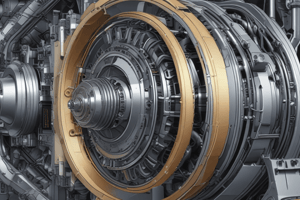Podcast
Questions and Answers
Why does an induction motor need no electrical connections to the rotor?
Why does an induction motor need no electrical connections to the rotor?
- Because it operates on a wireless power transmission system
- Because it has a built-in battery for the rotor
- Because it uses a separate power source for the rotor
- Because the rotor obtains electric current by electromagnetic induction from the stator winding (correct)
What type of electric motor is an induction motor?
What type of electric motor is an induction motor?
- AC electric motor (correct)
- DC electric motor
- Hybrid electric motor
- Mechanical electric motor
Which type of rotor can an induction motor have?
Which type of rotor can an induction motor have?
- Brushed type or brushless type
- Permanent magnet type
- Hybrid type
- Wound type or squirrel-cage type (correct)
For what are single-phase induction motors extensively used?
For what are single-phase induction motors extensively used?
Why are three-phase squirrel-cage induction motors widely used as industrial drives?
Why are three-phase squirrel-cage induction motors widely used as industrial drives?
What term describes the effect of inducing a varying electromotive force (EMF) across coils in a transformer's core due to a varying magnetic flux?
What term describes the effect of inducing a varying electromotive force (EMF) across coils in a transformer's core due to a varying magnetic flux?
What type of transformer is used to decrease voltage levels?
What type of transformer is used to decrease voltage levels?
What is the main purpose of using transformers in signal-processing circuits?
What is the main purpose of using transformers in signal-processing circuits?
What type of transformer is designed to have no electrical connection between its primary and secondary windings?
What type of transformer is designed to have no electrical connection between its primary and secondary windings?
Which property does an ideal transformer possess?
Which property does an ideal transformer possess?
Flashcards are hidden until you start studying





